We all know we should be keeping the sweet stuff to a minimum. But are you aware of how much sugar you are really eating in a day? Three women keep food diaries and are shocked at their results
Sugar is public enemy number one when you look at the evidence stacked against it. Heart disease, type 2 diabetes, tooth decay, liver disease and cancer have all been linked to excess consumption. Not to mention obesity, which 26 per cent of adults were classified as in 2016.
The average British adult is getting 57g of free sugar a day – nearly twice the recommended amount
A lot of us admit to being a borderline sugar addict, but how many of us really know how much we are eating? Those afternoon biscuits, fizzy drinks with meals and late night comforts really do add up – ‘We should not be eating more than 30g of added sugar (around 7 teaspoons) a day’, says Helen Bond, consultant and dietician. However, ‘the average British adult is getting through 57g of free sugar a day.’ Eek… These are mainly from table sugar, such as preserves, sweets, chocolate and even chewing gum.
The 101 on sugar
Let’s get into the nitty gritty. The term ‘added sugar’, actually refers to ‘free sugars’, and they are the ones we should be wary of. Free sugars are those added to food, such as highly processed confectionary. However, they are also naturally present in honey, syrups and fruit juices. The other sugars are natural occurring sugars are found in whole fruit and vegetables and milk and dairy products.

Sugars come in natural and added forms
The Reference Intake (new term for Guideline Daily Amount) for total sugars is 90g a day. This is essentially 30g of added or ‘free sugars’, and 60g maximum of natural sugars.
Let’s look at a fruit bowl – a medium size banana contains 7g of sugar, an apple 16g, and an orange 12g. So, should we be restricting our fruit intake? ‘In my point of view, I’m not worried about sugar in fruit’, says Helen. ‘It comes with fibre, vitamins, minerals and water – this combination is not harmful and is generally good for us.
Many of us still fail to reach the recommended 5-A-Day. Only 29 per cent of UK men and 32% of women aged 19-64 year olds’, says Helen. In contrast, those free sugars are not necessary for a healthy diet and won’t be doing too much other than add to our waistlines and health woes.
How to read the label
Although the guidelines are clear, the labels are not so. ‘The problem we have is when you look at labels on a pack, they don’t differentiate between natural sugars and the added free sugars’, says Helen.
Even something like baked which is tomato based can have a lot of added sugar
What’s more, some things may seem healthy on the outside, but are hiding some of the bad sugars. A recent study that analysed the nutrients of almost 900 yoghurts on supermarket shelves found that some may contain more sugar than Coca Cola.
Fewer than one in ten categories of yoghurt sold qualify as low-sugar, with organic and those marketed at children being amongst the most sugary – the shock horror. ‘Things like yoghurts, fruit based products and even something like baked which is tomato based can have a lot of added sugar. Hence why a lot of people are confused’, says Helen.
As a rule of thumb, use the traffic light system, or ‘carbohydrates (of which sugars)’ figure in the nutrition label to guide you:
- More than 22.5 of total sugars per 100g is high
- 5g of total sugars or less per 100g is low
If the amount of sugars per 100g is between these figures, it’s a medium amount of sugars.

Use the traffic code systems on labels
‘Then I would go to ingredient list and get familiar with the many names sugar comes under’, says Helen. ‘Usually anything with ‘-ose’ at the end tends to be sugar but it comes in other forms such as honey syrups and juices, and trendy ones like agave and nectar. If sugar comes up as the first two ingredients, you can get the idea that it’s normally a high sugar product.’
How much sugar are THEY really eating? The sugar diaries
Helen looked at three case studies of women with various levels of ‘addiction’ to sugar to assess just how easy these ‘free sugars’ are creeping in.
Healthista asked the women, Kirstie Johnson, 22, Laura May, 39 and our very own editor Anna Magee, 49, to keep an honest week’s food diary, ready to be critiqued…
The sugar and caffeine junkie
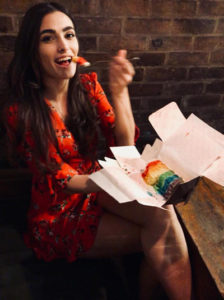 Kirstie Johnson, 22
Kirstie Johnson, 22
Goals: Better skin, stable mood, leaner body.
Week total sugars: 1440g
Average day: 200g
*For the full food diary please see bottom of page.
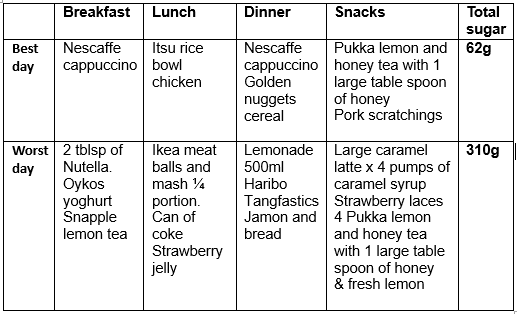
I rely on sugar and caffeine
‘On a normal day I’m on my feet for about 8-10 hours as a Head Vetinary Nurse and I rely on sugar and caffeine. Within the day, I have bursts of extreme energy and then all of a sudden I’ll be crashing and half asleep. I don’t sleep very well either.
‘I’m on a prescription at the moment to control acne. My diet was discussed, but due to my work life, it wasn’t something I felt I could change. Picking at sweets and having drinks is a lot easier for me.
‘I am currently 55kg (8.6 stone) but I would like be leaner. I’ve got bits of fat on my tummy and hips and I think that’s a lot harder to shift because of my diet.’
Helen’s verdict: ‘Kirstie’s sugar diary was the most shocking. If she has a 190g bag of Haribo’s in one sitting, that alone is three times the recommended maximum limit of free sugars in a day (30g).
On Saturday, she has 250g which is eight times the recommended amount. Her habits include having lattes with four pumps of caramel syrup and whipped cream. Every pump is an extra teaspoon of suga
Kirstie’s sugar diary was the most shocking
‘Kirstie is obviously very busy and fuels herself with sugar and caffeine. These spikes in blood sugar levels will affect her mood and skin. A high sugar diet can aggravate the balance of sex hormones which then causes spots.
‘Luckily for her, Kirstie has youth and good genes on her side. She has a high metabolism and is running around all day burning calories.
‘But things will slow down and things will catch up on her over time. What’s worrying is that she appears lean or slim, but her body is what we would call TOFI – thin on the outside and fat on the inside. Someone might look well, but on the inside it’s not so healthy.’
Is your diet like Kirstie’s? Follow Helen’s recommendations:
- Start slow and steady with small steps: Kirstie obviously needs to cut down on sugar.
- She can start with using diet drinks instead of fizzy drinks [one can of coke contains 33g of sugar] or a Splenda Mini in her coffee or tea.
- Low calorie sweetners do get a lot of bad press and usually its one bad study that causes controversy. But if you look at the evidence, they are one of the most rigorously studied ingredients and they are completely safe.They hugely help people who eat a lot of sugar.
- Instead of 2tbsp of Nutella for breakfast, peanut butter would provide protein and make her feel fuller. These will make a big difference to the free sugars intake.

Swapping to diet drinks would make a big difference
- Low GI diet: There is a lot of evidence for a low GI diet when treating acne. These are foods that release energy slowly instead of spiking blood sugar levels. I would recommend wholegrains, such as wholemeal bread and rice [instead of white], buckwheat and quinoa.
- More plant based: Kirstie needs more fruits and vegetables in her diet. Enhancing the nutrients in her diet would benefit her skin, B vitamins, and regulate blood sugar levels.
- Introduce more good fats: A lot of people with oily or bad skin think they shouldn’t have more fat. But oily fish and omega 3 will dampen down inflammation in the body.
- Be organised: Try and get healthy snacks pre-prepared and avoid buying sweets that lie around that are tempting.
The weight watcher
 Laura May, 39
Laura May, 39
Goals: Weight loss and pain management
Week total sugars: 365g
Average day: 50g
*For the full food diary please see bottom of page.
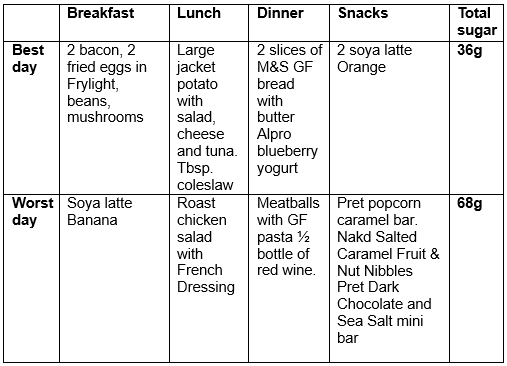
I’m struggling to lose another stone… without eating rabbit food
‘My relationship with sugar is mostly reliance and denial. I work full time and have a 14 month old daughter, Frankie.
‘Having a baby and being diagnosed with Fibromyalgia changed a lot for me. It’s a chronic pain disorder which makes me feel very fatigued. It can feel like I’m carrying extra weight, trying to run through a swimming pool.
‘Six weeks ago I went gluten and diary free. It took away 60-70 per cent of my Fibromyalgia and IBS symptoms, as well as clearing up my skin. At the moment this is more of a priority for me than my sugar intake.
‘I lost a stone after having my baby but I’m struggling to lose another stone and feel ‘myself’ again. I don’t know how to approach it without eating rabbit food.
‘I don’t sleep much, on average six hours a night because of the baby. Then I’ll turn to things full of sugar to get an energy spike. I never ate so much chocolate before I had a baby.’
Helen says: ‘Laura has had a tough time. But she is well within the 90g recommendation and that’s mainly because she’s clearly substituting some processed foods.
Her free sugars are creeping in with biscuits and I worry about the coffee shop treats like the Pret popcorn bar.
However her choices aren’t all bad. For example, she has a KIND Caramel Almond and Sea Salt Bar which has almonds in and is low sugar.
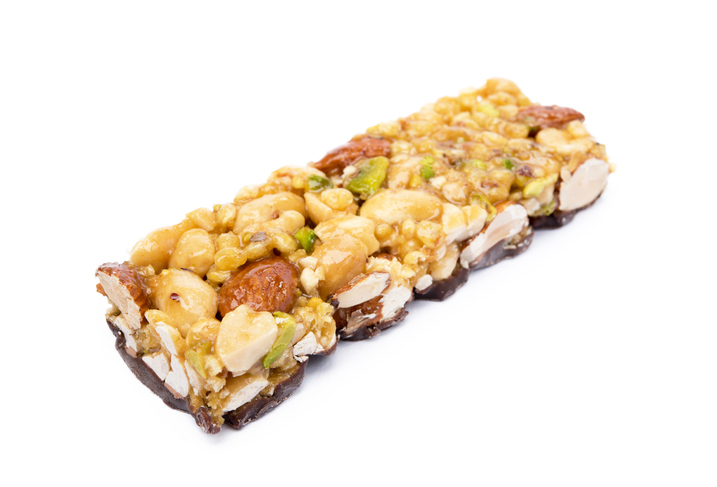
The glasses of Prosecco on a Friday night stood out to me. Even as a lower sugar drink, each glass has 1.5g of sugar, which is a teaspoon after three glasses.
Alcohol contributes to 9 per cent of our sugar intake. Laura is choosing red wine, with no sugar, over sweeter wines. This is good, but there are still a lot of calories in there. Sugar is only part of the picture.
Milk alternatives contain free sugars, whereas milk lattes only have naturally occurring sugars.
As she is dairy free, she is having soya lattes. Soya lattes per 266ml contain roughly 113 kcals and 6g sugars. All sugars naturally present in dairy alternative drinks such as soya, rice, oat and nut-based drinks’ are now included in the definition of free sugars, whereas milk lattes only have naturally occurring sugars.
An important thing to remember is that dairy or gluten free are not necessarily healthier options and can be higher in sugar, fat and calories, and lower in B vitamins which we need for energy.
It may be helping her symptoms now, but there isn’t evidence to support it will work for fibromyalgia and she might not have to eat this way forever.
Is your diet like Laura’s? Follow Helen’s recommendations:
- Get adventurous with grains: Laura is lacking in wholegrains with fibre. It’s great she cooks from scratch and she can try gluten free grains such as pulses, teff, brown rice and quinoa to get more nutrient variety. A portion should be the size of a tennis ball, as too much can make you sleepy. Many of us still think that carbs should be off limits if we’re trying to lose weight. But the latest scientific evidence confirms foods rich in starchy carbohydrates are an essential part of a healthy, balanced diet and are good at keeping our digestive system healthy, and a great choice for filling us up, in turn helping to prevent hunger, which can lead to overeating.
- Rather than getting her sugar fixes from bars and popcorn, she might find she’s OK with oats with oats which aren’t gluten free. Oatcakes with avocado or nut butter would be a good snack.
- Home baking: Working in an office can be dangerous as temptation is often laying everywhere. I would recommend Laura makes gluten free biscuits at home. You know what’s going in there and can use sugar substitutions to cut down free sugars and calories massively.

Home baking can cut down sugars
- Improve sleep quality: Not having enough will affect her hormones and it will stimulate her hunger signals. Light exercise and carbohydrates in an evening meal to make you feel more sleepy. If she decides to have dairy again, a glass of warm milk helps to boost serotonin, which at night time turns to melatonin which makes you sleepy. She should also be careful to avoid caffeine up to five hours before bed. (Try Healthista Night Food, £18.95)
- Mediterranean style diet: This diet is low in sugars and has a lot of healthy fats. It encompasses a lot of the food groups that are good for overall health and wellbeing. It can dampen inflammation in the body from free radicals and wouldn’t aggravate her symptoms.
The health-aware sugar addict
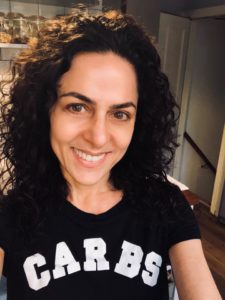 Anna Magee, 49
Anna Magee, 49
Goals: More energy, better ageing, stable mood
Week sugar total: 520g
Average day: 75g
*For the full food diary please see bottom of page.
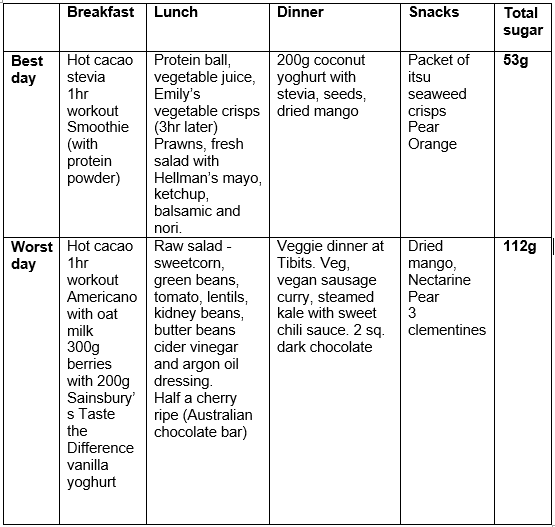
I like to snack on fruit – I can have five pieces in one sitting
‘Writing this diary has made me realise what a sugar junkie I am and how erratic my eating is. I can’t live without fruit and little bits of sugar every day. I like to snack on fruit – I can have five pieces in one sitting – but I don’t have things like dessert, cookies or cake unless it’s a celebration.
‘I don’t feel restricted, but I do have a sweet tooth, especially after and between meals, and will find ways around it with things like grapes, sweetcorn in my salad, sweet chilli on kale, or oat milk in my coffee.
‘I’ve given up sugar entirely before – it was hard for three weeks but then I didn’t even think about it. It really improved my mood. I hope the solution isn’t to eat more things like cheese – I don’t like cheese and I’m mostly vegan!’
Helen’s verdict: ‘Anna’s overall diet is very healthy, and her daily free sugars are under the limit (30g) at roughly 18g, apart from a slice of cake at the weekend.
‘The rest of her sugars come from natural sources such as fruit and salad bowls, totally under 90g. I’m not worried about Anna’s sugars at all.
Anna is underfueling her body and her meal times are erratic.
‘Her calorie intake is lacking sometimes and she does a lot of high intensity workouts. Her lunch is averaging about 470 calories, which is probably why she snacks.
‘Anna doesn’t always have conventional lunchtime meals, but on average, her ‘lunch’ intake for the week is 472 kcals and on Thursday it was just 339 kcals – falling short of PHE’s 600 calorie lunch recommendation. Underfuelling by 128 kcals + may contribute to her mid–afternoon energy lows.
‘Although Anna doesn’t want to overload on food at lunch (as it can contribute to a ‘postpandrial dip’ after a heavy meal), she exercises regularly so does needs to eat more carbohydrate calories to replace the fuel that she has burned in her morning exercise, so I would suggest adding in a portion of wholegrain carbs, such as a small serving of brown pasta of brown rice or quinoa, or a small wholemeal pitta or tortilla wrap.
‘On days when Anna is less active, she will need fewer carbs but again going too low, may leave Anna feeling very tired.
‘The recommended daily calorie intake for women is 2000 kcals but in reality our calorie requirements are very individual and depend on how old, big, tall and active we are, among other things. This is just a guide but it is also useful for Anna to keep an eye on her weight – Anna is already lovely and slim, so if her weight is falling, then her body is burning more calories than she is consuming and may need to up her calorie intake.
‘On a good note, her protein intake is well within, almost double, the benchmark. This is from her plant based sources such as beans, nuts seeds and protein powder. Her fibre intake is also excellent.’
Is your diet like Anna’s? Follow Helen’s recommendations:
- One of Anna’s main sources of free sugar is from the honey in her smoothie. A lot of people still think of honey as a ‘natural sugar’, but it still counts as a free sugar. A tbsp. is about 12g of sugar which is almost 3tsp of sugar. This is where Anna could try a sugar alternative.
- Another surprising high sugar ingredient is sweet chilli sauce, which Anna uses occasionally. And a tbsp of balsamic vinegar gives about 6.5g of free sugars and the third and fourth ingredients on the label are sugar.

Honey has about 12g of sugar per tablespoon
- To improve energy, I would suggest upping carbohydrates to steady Anna’s levels and balance her mood and psychological wellbeing.
- I would check Anna’s iron and vitamin B12 levels as she is mostly vegan. The latter is exclusively within animal products. Often you need a supplement or fortified foods.
- For healthy ageing, I’d suggest vitamin D and omega 3 supplements. Anna doesn’t really have oily fish, which I would recommend if she can. This is good for heart health and skin. If she doesn’t like this, I would suggest walnuts, flaxseeds and linseeds.
Should I go sugar free?
There is a war on sugar, but there’s no need to eliminate it from the diet. ‘A sugar free diet is virtually impossible and not recommended’, says Helen.
‘We need to look at the balance of a diet and where those extra calories comes from. A sugary diet comes hand in hand with fatty foods like chocolate, which are usually low in nutrients and fibre.’
Chose high fibre carbs to reach the daily fibre goal of 50g and gain a slow release of energy
It’s the balance of protein, carbs and fats that will keep you craving the sugar laiden stuff. ‘You need a good balance of macronutrients in all meals and snacks as the combination slows down the absorption and release of carbohydrates into our bloodstream’, says Helen.
‘Carbohydrates have had a lot of bad press over the years. But really they should be about 50 per cent’, she says.
Choose high fibre carbs such as quinoa, buckwheat, millet and sweet potato to reach the daily fibre goal of 50g and gain a slow release of energy. This could be as simple as swapping your morning sugary cereal for a wholegrain bran. ‘Otherwise you’re going to feel tired and in low mood’, says Helen.

A balanced meal with wholegrain carbs will sustain energy
Considering a ‘sweet tooth’, is something humans evolve to have from the moment they taste breastmilk, so how can we satisfy the primal need without going overboard on sugar?
Get smart on sugar instead
‘It’s about using sugar cleverly’, says Helen. ‘It’s almost habitual to have something sweet after dinner but it’s small changes such as having dried fruits like raisins and apricots instead of chocolate.
‘These things don’t have a halo top over them – you can’t eat a whole bag of raisins and should stick to a 30g portion. But cutting down on the refined sugars is going to be a good thing.’
READ MORE
Is sugar sabotaging your sex life?
I gave up sugar for 30 days and this is what happened
6 easy swaps to lower your sugar intake
 Helen Bond BSc (Hons), State Registered Dietitian has over 20 years’ experience in food, diet and its
Helen Bond BSc (Hons), State Registered Dietitian has over 20 years’ experience in food, diet and its
relationship to health. Helen is fully registered with the British Dietetic Association, the Freelance Dietitians Group and the Health and Care Professions Council.
*Full diaries revealed:
Kirstie Johnson
| Breakfast | Lunch | Dinner | Snacks | Total sugars | |
| Monday | 2 cookies | Haribo starmix | Toast with butter and marmite Lemonade 500ml | Nescaffe cappuccino 2 Pukka lemon and honey tea with 1 large table spoon of honey | 143g |
| Tuesday | Nescaffe cappuccino coffee | Chicken and grain salad Lemonade 500ml | Grapes red Whetherspoons fries and ketchup | Starbucks caramel latte and whipped cream Pukka lemon and honey tea with 1 large table spoon of honey | 149g |
| Wednesday | Nescaffe cappuccino | Itsu rice bowl chicken | Nescaffe cappuccino Golden nuggets cereal | Pukka lemon and honey tea with 1 large table spoon of honey Pork scratchings
| 62g |
| Thursday | Nescaffe cappuccino | Snapple lemon tea | Golden nuggets cereal Snapple lemon tea | Starbucks caramel latte and whipped cream Large dairy milk Oreo choc bar Can of coke | 264g |
| Friday | Starbucks caramel latte and whipped cream | Latte Chicken and lettuce sandwich | Beef stew Grilled peppers Can of coke | Starbucks caramel latte and whipped cream Can of coke | 262 |
| Saturday | 2 tblsp of Nutella. Oykos yoghurt Snapple lemon tea | Meat balls and mash. Can of coke Strawberry jelly | Lemonade 500ml Haribo Tangfastics Jamon and bread | Large caramel latte x 4 pumps of caramel syrup Strawberry laces 4 Pukka lemon and honey tea with 1 large table spoon of honey & fresh lemon | 310g |
| Sunday | Starbucks caramel latte and whipped cream ½ chocolate croissant | Snapple lemon tea Tuna pasta | Quorn chicken curry | Caffe Nero Caramel latte and whipped cream Haribo Tangfastics | 262g |
Laura May
| Breakfast | Lunch | Dinner | Snacks | Total sugars | |
| Monday | Soya latte Kind Caramel Almond and Sea Salt Bar | Roast Chicken salad with French Dressing | Salmon, basmati rice, and veg stir fry | Oat milk latte Banana 2 oranges 3 squares of M&S 72% dark chocolate | 56g |
| Tuesday | 2 bacon, 2 fried eggs in frylight, beans, mushrooms | Jacket potato with salad, cheese, tuna and coleslaw | 2 slices of M&S GF bread with butter Alpro blueberry yogurt | 2 soya latte Orange | 35.5 |
| Wednesday | Soya latte Banana | Roast chicken salad with French Dressing | Meatballs with GF pasta ½ bottle of red wine. | Pret popcorn caramel bar. Nakd Salted Caramel Fruit & Nut Nibbles Pret Dark Chocolate and Sea Salt mini bar | 68g |
| Thursday | Beans, scrambled egg, 2 slices of M&S GF bread Soya latte | Soya latte Sainsbury’s Sweet Chilli Chicken Noodles 2 mini Costa GF cherry bakewells | Chicken thigh tray bake with veg, rice ½ bottle of red wine | 2 rice crackers with dark chocolate ½ bag of large M&S crisps | 48.4 (add 5 if big tin beans) |
| Friday | Soya latte Pret popcorn caramel bar. | Wasabi Rainbow set Sushi | Lamb, chicken, spiced veg (restaurant) ½ bottle of wine 3 glasses of prosecco Old Fashioned | ½ bar of M&S dark choc 72% | 46g |
| Saturday | Salmon and scrambled eggs2 slices of GF toast with butter. | GF chocolate chip cookies | Harissa Chicken Casserole mash and veg | Half a packet of large M&S crisps Biscuit Stabucks GF nut and dry fruit bar Soya latte 1/3 bottle of red wine. | 49g |
| Sunday | 2 sausages, beans, 2 eggs, mushrooms | Harissa Chicken Casserole mash and veg | Half a banana, strawberries 2 GF chocolate chip cookies Soya Latte GF mini cherry bakewell. 1 orange ½ bottle of red wine. | 62g |
Anna Magee
| Breakfast | Lunch | Dinner | Snacks | Total sugars | |
| Monday | 1hr workout Hot cacao and Americano with oat milk 300g berries with Sainsbury’s vanilla yoghurt | Raw vegan salad including beans and oil dressing Half a cherry ripe (Australian chocolate bar) | Vegan sausage curry and drizzled steamed kale with sweet chili sauce. (restautrant) 2 sqs dark chocolate | Dried mango Nectarine Pear 3 clementines | 112g |
| Tuesday | Smoothie – protein powder banana, chia and flax seeds 20g, honey, peanut butter. Americano | Raw salad, as above | Courgetti, Sacla pesto, avocado, veg, itsu seaweed, 1 tsp almond butter 2 nectarines | 3 clementines | 60g |
| Wednesday | Workout Smoothie as above | Pret roasted seeds (3 hours later) Raw salad | 3 fish canapes with sweet chilli sauce (2 hours later) Banana, macadamia nuts, sultanas, yoghurt with stevia | Booja booja vegan ice cream. 2 clemetines | 75g |
| Thursday | 1hr workout Smoothie as above Americano with milk | Raw salad with olives and brazil nuts | 2 poached sea bass, mushrooms and spinach in butter, salad with 1 tbsp olive oil | 4 clementines Lola’s vegan fudge cupcake | 60g |
| Friday | Americano with oat milk 300g berries with Sainsbury’s vanilla yoghurt | Raw salad with oil and balsamic dressing. 1/3 cherry ripe bar. Satsuma | Seaweed spaghetti with homemade tomato sauce and fresh salad | Handful red grapes 5 almonds | 67g |
| Saturday | Smoothie Oats | Costa carrot cake Americano with milk | Veg Thali at Indian restaurant – Dahl, pickled veg, rice and 3 pappadums with chutneys. | PHD protein bar Raisins and macadamia nuts | 94g |
| Sunday | Hot cacao stevia 1hr workout Smoothie (with protein powder) | Protein ball, vegetable juice, Emily’s vegetable crisps (3hr later) | 200g coconut yoghurt with stevia, mixed seeds, dried mango | Packet of itsu seaweed crisps. 1 pear 1 orange | 53g |
